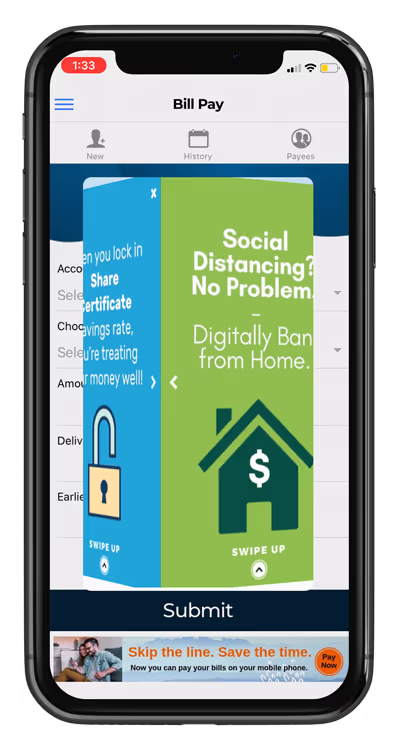1) Content Marketing
Before delving into the important online banking channel for marketing, it is important to review the other digital channels available and the strategies that can be used to drive more interest from prospects as well as members/customers of the financial institution.
Content marketing is a strategic marketing approach focused on creating and distributing valuable, relevant, and consistent content to attract and retain a clearly defined audience. Most modern marketers understand and embrace this concept. Instead of merely pitching your products or services, you are providing truly relevant and useful content to your prospects and customers to help them solve their issues.
In the case of banks, this could involve financial wellness strategies and advice, information on how to determine the best interest rates for a loan, financial calculators and worksheets, infographics to help young generations focus on savings, and more!
Optimization Can Drive Your Bank's Site to New Heights
High quality content provides information and entertainment, which, ironically, makes it a more powerful selling tool. Content generates trust, which generates the confidence to invest in a company’s products and services. Your financial institution won’t do very well if your customers don’t trust you.
Financial content marketing does not cost a lot to produce and even less to publish because it’s typically added to the bank’s own website. This type of marketing, especially when the content is of high-quality (and therefore useful to banking consumers), can often generate leads and even customers. In short, content has the potential to yield higher revenue at lower costs.
Unlike paid advertisements, good content can go viral thanks to consumers sharing it on social media. Your blog might be read by only a few people on your website, but each reader could share it with many friends and associates. That kind of reach is very effective and much more affordable than anything you can accomplish with traditional marketing or advertising.
Websites with more than 400 pages generate six times more leads than sites with fewer than 100 pages. The more relevant keywords targeted through a bank’s content, plus the number of links this content can attract, can ensure that their website ranks higher in search engines. And because useful expertise and guidance can help build trust among current and potential customers, it’s important to come up with content that demonstrates a bank’s financial expertise, depth of financial knowledge, and its reliability in the community.
2) Email Marketing
Email marketing continues to be a marketing channel with one of the highest returns on investment (ROI) rates. It is highly automated and therefore very efficient. People continue to use email heavily for communication. Therefore, when deployed correctly, it can be very effective as a financial marketing tool.
Strategies that help in deploying for optimum returns include regular and balanced cadence of emails sent, personalized messages, relevant subject lines, short and sweet copy (remember, that recipients are getting 100s of emails, so a long-winded one will be one of the first to be discarded), creation of value, and clear call to actions.

3) Personalized and Retargeted Ads
A highly effective way to engage banking consumers is by sending them highly personalized and targeted messages and ads. Mass marketing is way beyond dead; it is considered the “lazy” marketing tactic in the modern world. With so many data insights available, taking the time and effort to personalize messaging and offers will yield amazing returns.
Additionally, there are customer data platforms (CDP) and digital experience platforms (DXP) that can transform a chore into personalized and adaptive user experiences that are simply amazing.
4) Social Media Presense
Over recent years, the growth of social media has made it clear that these modern communication platforms should be part of any brand’s primary marketing channels. That includes financial institutions such as banks and credit unions! Some important statistics for a bank to consider:
• The average daily usage of social media is 2 hours and 27 minutes
• 6 out of every 10 people on the planet have a social network account
• 85% of marketers rate short-form videos as the most effective type of social media content
• Almost 45% of internet users research products on social media.
With all of this in mind, it’s important that this channel not be ignored by a bank. Some of the most popular social media networks for consumers include Facebook, Instagram, YouTube and Twitter.
According to ABA, this social media presence is actively in use by banks of varying sizes. Strategies for using this channel are topped by community engagement, followed by the desire to deepen existing customer relationships by providing such content as financial tips and updates on new products or services.
5) In-App Advertisements for Existing Customers
Search Engine Optimization (SEO) can be a powerful tool in a bank marketing strategy, especially with bringing in new customers in an organic way. It is a cost-effective approach that reaches more consumers online through valuable content marketing. SEO works by delivering great content to your prospective customers – this in turn will be noticed by search engines, like Google, and your page will be ranked higher on search results pages!

Online and Mobile Banking is Paramount for Today's Consumer
Online and mobile banking has become a pervasive application for consumers in how they bank and this is only going to grow as we look into the future of this industry. The convenience and security of online and mobile banking gives consumers high confidence in these platforms.
As consumers continue to reduce physical interaction with banks, it becomes imperative that banks figure out a way to effectively engage and communicate with their customers digitally. Fortunately, there have been several advancements in marketing tech that allow banks of all sizes to create and implement digital marketing strategies that are proven to work effectively and affordably.
DeepTarget Provides In-Depth Solutions for OLB Marketing
DeepTarget helps financial institutions grow by simplifying their digital marketing in order to deliver amazing experiences that result in up to 10X more sales and lasting relationships with their digital users. Our patented Digital Experience Platform (DXP) integrates data sources for the purpose of driving meaningful digital engagements that yield more loans and deposits for financial institutions of all sizes. This is done through various channels that include online banking, mobile banking, e-statement portals, email and the web.
These intelligence-based digital marketing automation and sales solutions are used by hundreds of financial institutions. to provide a seamless communications experience wherever, whenever, and however their customers bank!
We Use Existing Business Intelligence to Drive Campaigns
Financial institutions collect various types of information about their account holders. This information is provided securely by financial institution customers to the DeepTarget engine as one of the data sources used in order to enable accurate targeting of relevant communications in the various digital channels.
Personalized Marketing for Your Audience
By utilizing consumer data insights, other business insights, and AI, DeepTarget provides financial institutions with the ability to accurately target and personalize its digital marketing communications.
Personalization can include any attribute in the database such as first name, account balance, credit card spend balance, a specific interest rate on a loan and so on. The broader and deeper that consumer data is available, the more optimal the personalization is. Given that the FI is communicating with the consumer in a digital authenticated app securely, the consumer is more apt to view this as a positive experience.









